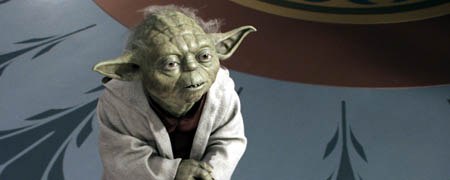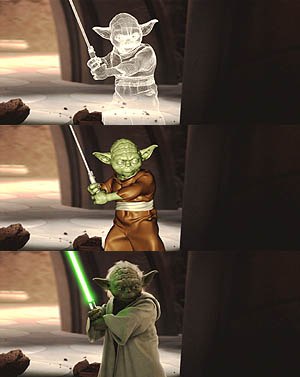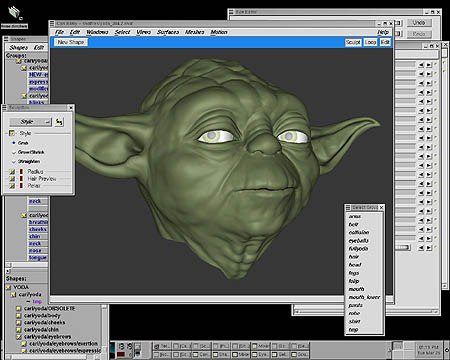We've all been waiting to see Yoda in a light saber duel and Star Wars Episode II does not miss the mark. Bill Desowitz speaks with ILM on how they created Yoda in CGI and brought him to action.
One of the biggest animated challenges in Star Wars Episode II: Attack of the Clones was making an all CG Yoda for the entire film -- a first for the franchise. In Phantom Menace, he was only CG in two wide-angle shots of him walking. A combination of puppet and CGI was also considered, but after a successful test, George Lucas and his staff at Industrial Light & Magic decided to go all animated when they realized they could have a lot more control.

The CG version of Yoda allowed the animators to add depth and expression to his eyes. All images © Lucasfilm Ltd. & TM. All rights reserved. Digital work by Industrial Light & Magic.
From Puppet to CG
"We considered Yoda from The Empire Strikes Back and asked, 'What makes Yoda Yoda?'" explains Tim Harrington, senior computer graphics animator. "Frank Oz's puppetry, subtle nuances, the heavy eyelids over the pupils, how his ears jiggle. We were going after the essence of Oz."
Initially, the digital Yoda was greenlighted by animation tests done by Linda Bel, Hal Hickel and Kevin Martel. As production began, animation leads Linda Bel, Tim Harrington and Jamy Wheless supervised a team of over 10 animators to complete the Yoda shots.

Making Yoda a master swordsman was a challenge for the animators.
"We didn't want a little green man," Harrington adds. "But we didn't want him too perfect, so we dialed back a bit. Softimage is part of the pipeline for character animation, so we used SGI hardware. However, in mid-production, we used Linux machines, which are much faster than SGI 02s."
The technical directors matched the color and texture of the Phantom Menace puppet in creating the CG Yoda, which is much warmer than the blue and dark-looking one from Empire. At the same time, animators key-framed the character traits of the Yoda puppet from Empire Strikes Back into the digital Yoda. "We added more expressions to the eyebrows and the looks on his face," Harrington offers. "We had a lot more control over the eyes with the CG Yoda. More eye dart. His thoughts are more mischievous and intelligent to counter what he's saying. If you notice, puppets have a lack of focus in their eyes. It really improved the performance. His looks suggest a far more cunning character than is suggested when he speaks. That dichotomy comes through a lot more clearly than in Empire or Phantom Menace."

The digital progression of Yoda from wireframe, to lo-resolution render to final composite.
THE Scene
Not surprisingly, most of the effort went into the battle with Count Dooku. Lucas presented an animatic of Yoda fighting with a light saber. "George was adamant that Yoda be a master swordsman," Harrington stresses. "The fan in us thought it was cool, but the artist in us became cynical. How do you pull this off and not have it look ridiculous? Does Yoda create multiples of himself? Does he fly? Does he use the Force? One of the ways to make it believable was to lead the audience on -- to show them that here comes something that you've never seen before. When he pulls out that light saber, it's a very dramatic entrance. George said it should be a showdown like in a Western, and then suggested, 'What if he pulls at his robe to reveal the light saber?' It was a technological nightmare. Cloth is so difficult.
"I animated Yoda pantomiming the movement where he grabs the robe. I figured out the exact frame he touches it with the technical animator and we tacked the cloth to Yoda's hand to give it that Western feel."
Indeed, it's a moment we've all been waiting for, but certainly not from Yoda. Lucas and his animators decided to start with a test of wills using the Force, as Yoda absorbs lightening and then repels and hurls a series of heavy objects. For this part of the sequence, the animators referred a lot to Empire to figure out how Yoda uses the Force during Luke Skywalker's pivotal training sequence.

Getting Yoda's facial expression was a priority for the animators. Here's a screen grab from the Linux Platform showing ILM's proprietary facial animation software.
But inevitably the two Jedi masters do battle with their light sabers as in a samurai movie. "The sequence took three months with a team of nine animators," Harrington adds. "We choreographed the moves in a reverse way, like solving a puzzle. Looking, fighting, countering Dooku's moves. Each one looked like a check. We used background plates of Lee and his double matched to Yoda. The hard part was figuring out how Yoda fights because he's so small. We looked at a bunch of films and came up with the moves. We looked at tennis, we looked at samurai, we looked at acrobatic power moves in the circus. The Phantom Menace DVD was also very helpful because it had some cool new Jedi fighting moves that were explained in the supplementals. One of them was Obi Wan holding the light saber with two hands. We thought that would be good for Yoda too.
"George pointed out that Yoda's too small to stay on the ground, so he should do a lot of jumping and spinning. He should be more acrobatic than the other Jedi. But one of the first things we questioned was how to attack Dooku? Does he go for the legs? No, George said he wants to kill Dooku, so he should go for the head and the chest."

The warrior Yoda.
However, with all of the spinning that Yoda does, it was easy to crash the computer -- what they call "gimbal lock." When an object spins that much it confuses the computer, so ILM created a special rig using directional and up vector constructions. "This allowed us to control how he was rotated without confusing the computer. We had three rotation axes. It was a very daunting sequence, to say the least."
Then, after the fight, Lucas wanted to bring the viewer back to the reality of a more familiar Yoda, so he came up with the idea of Yoda being so wiped out that he picks up his cane and slowly drags it on the floor. "We wanted the audience to feel that it was now in the presence of the same Yoda we know and love."
Bill Desowitz is the former editor and managing editor of Animation Magazine, and writes about film regularly for the Los Angeles Times and the New York Times.







